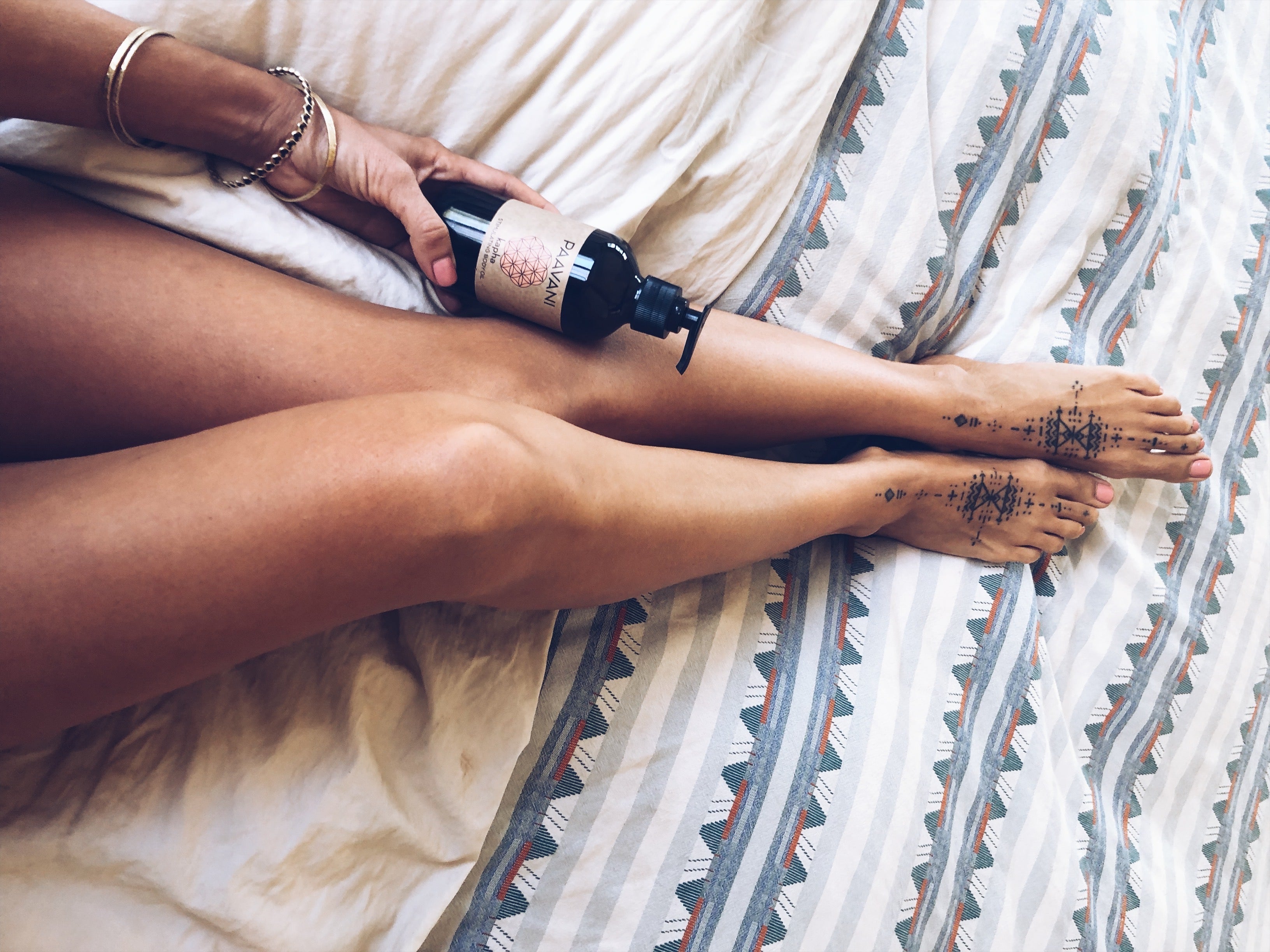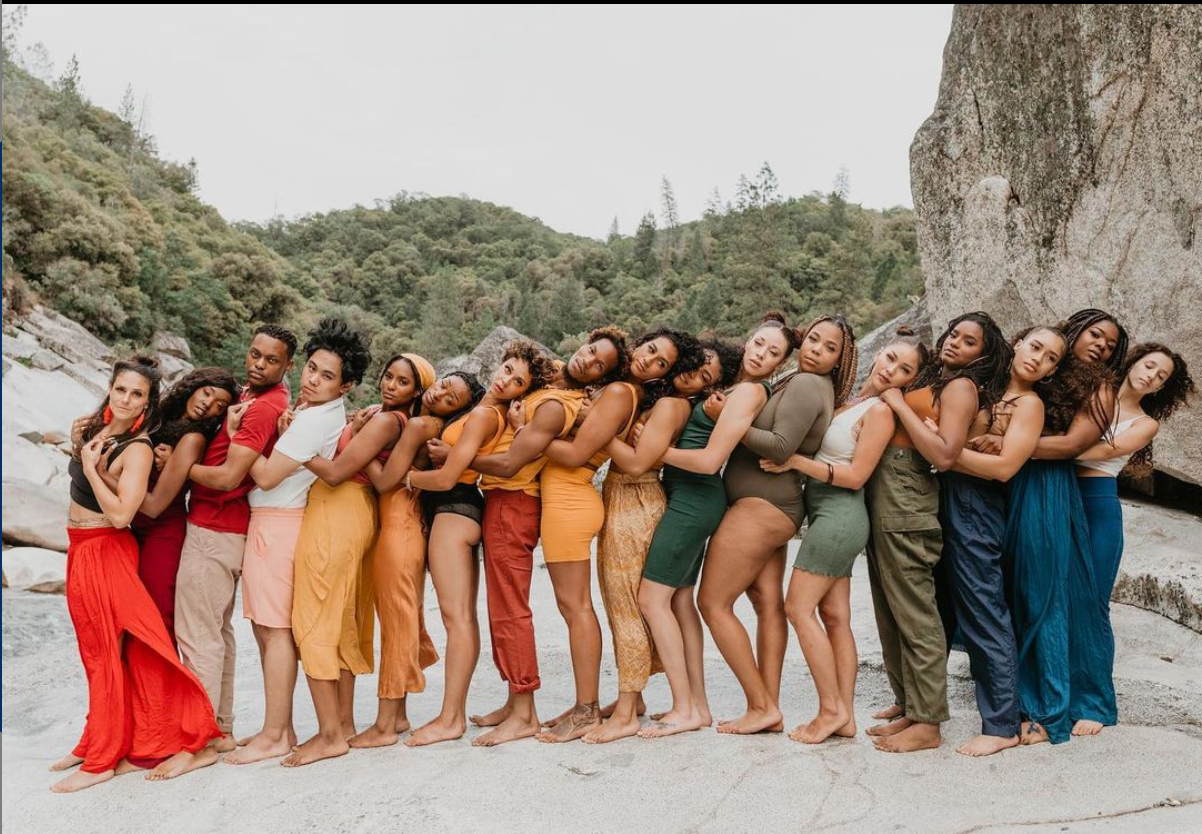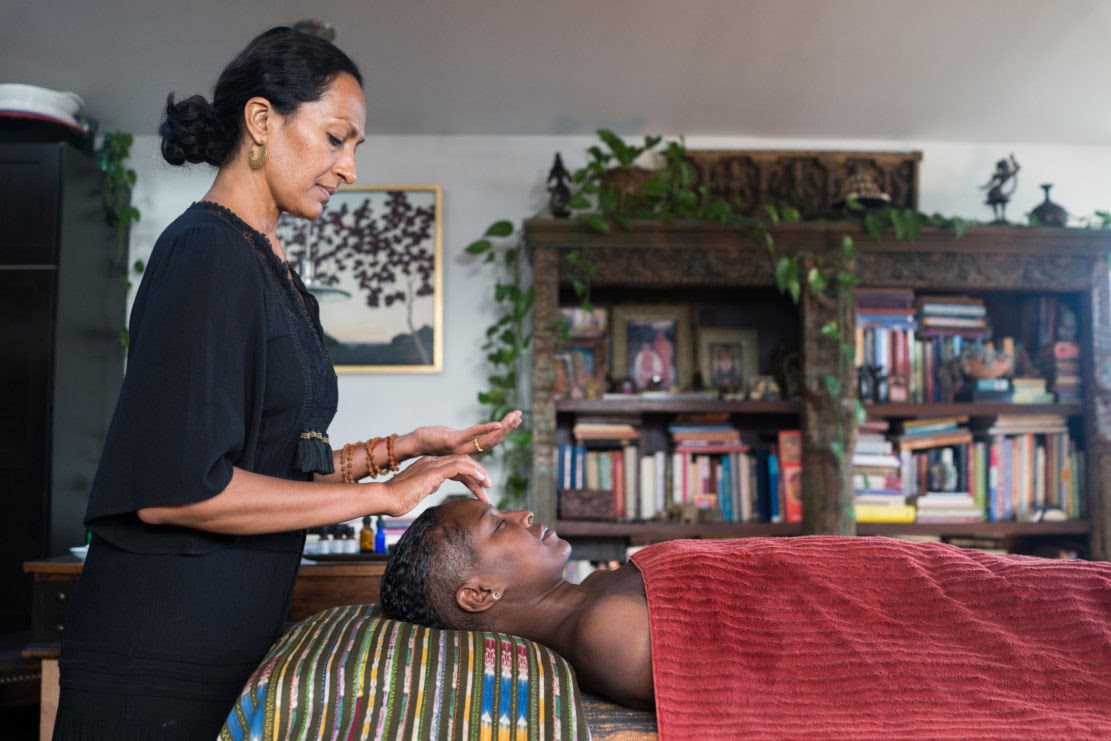
Radical Self-Love & The Best Abhyanga Oil for YOU!
With Valentine’s Day less than a week away, thoughts of hearts, chocolates, flowers and candle lit dinners may have infiltrated your mind. Yet, if you’re into Ayurveda, we would like to steer your Valentine’s Day thoughts over to oil! Think, all the warm, herbal, sumptuous oil that you can lovingly anoint yourself with. You see, in Ayurveda, ‘oil’ translates to ‘love’. The Sanskrit term snehana means ‘to oil oneself’ but it also means ‘to love oneself’; therefore, through oiling oneself, one loves themself, making oil the ultimate vessel for infusing yourself and the special people in your life with LOVE!
There are various ways one can oleate or oil the body. From the practice of nasya (nose oil), karna purana (ear oil), kavala graha (oil pulling) to anuvasana basti (oil enema), Ayurveda is all about the oil! Although we value all Ayurvedic oleation practices, our number one, can’t live without oil ritual is abhyanga. Abhyanga is the Sanskrit term for Ayurvedic massage. This type of massage works to rejuvenate and detoxify the lymphatic system, calm the mind and nervous system, stimulate digestion and elimination, moisturize and tone the skin, boost vitality and, as you may have guessed, cultivate self-love through the sense of touch.
Traditionally, abhyanga is performed with two Ayurvedic Practitioners working simultaneously, moving in unison as they glide and massage warm, herbal oil onto the client’s body. We highly recommend receiving an abhyanga from trained practitioners, as it is an incredibly nourishing, restorative experience; however, thankfully you need not wait until your next spa day to start integrating abhyanga into your self-care routine, as you can easily perform a self-abhyanga from the comfort of your own home. You can even get your honey in on the abhyanga fun, teaching him or her how to perform this massage and perhaps this Valentine’s Day, you both can give each other abhyangas to show your love.
Now that you have checked out self-abhyanga techniques, you may be wondering which oils will work best for your dosha...
Best Abhyanga Oils & Practices for Vata Dosha
The qualities which make up vata dosha include: cold, light, dry, mobile, sharp, rough, hard, flowing, subtle and clear. This means that people predominant in vata dosha have a tendency to feel cold, experience dry skin, constipation and non-smelly gas from weak digestion. In the mind, vata-types are prone to fear, anxiety and worry. According to Ayurvedic philosophy, in order to keep vata dosha in balance, it is best to counterbalance its qualities with their opposites: warm, heavy, moist, static, dull, smooth, soft, dense, gross and cloudy.
Thus, when searching for the best abhyanga oil for balancing vata dosha, we recommend sesame and almond oil. Both of these oils bring warm, heavy, dense, soft and smooth qualities to the skin, body and mind. If you choose sesame oil, find one that is untoasted and high quality, and as with all oils and herbal ingredients that we recommend, choose organic when available.
Our Vata Body Oil is prepared by the traditional Ayurvedic method of infusing whole herb ashwagandha, shatavari and cinnamon into sesame and almond oil. This oil preparation simmers for days so that the fat-soluble properties of the herbs can fully synthesize with the oil. We then add dosha balancing essential oils like lavender, marjoram, chamomile and vanilla bean to add aromatherapeutic scent and further healing.
Pro Tip: When performing an abhyanga specific for balancing vata dosha, make sure the oil is warmed to a pleasant temperature. You can do this by simply submerging your abhyanga oil container or bottle into a mini crockpot set to a low temperature. Don’t have a crockpot? Simply, place your abhyanga oil in a bowl of hot water until it reaches your desired temperature. While performing your abhyanga, spend some extra time rubbing the abdomen in a clockwise direction in order to encourage healthy bowel movements and a downward flow of energy.
Best Abhyanga Oils & Practices for Pitta Dosha
The qualities that comprise pitta dosha are hot, light, moist, static, sharp, rough, hard, subtle, flowing and clear. This translates to pitta-type people commonly feeling hot, suffering from sensitive and inflamed skin, hyper-acidity and smelly gas due to too much heat in the digestive tract. In the mind, pitta can evoke anger, resentment, criticism and create burn out. Ayurveda explains that balancing excess pitta dosha occurs by welcoming its opposing qualities of cold, heavy, dry, mobile, dull, smooth, soft, dense, gross and cloudy.
When looking for an abhyanga oil best suited for balancing pitta dosha, it is essential to choose an oil that imparts a cooling, heavy, soft and soothing energy. We do love coconut oil for its cooling quality; yet, we do not recommend using it topically as an abhyanga oil since it has a comedogenic (pore clogging) rating of 4 (on a scale of 1-4), and, with prolonged use, it has the potential to create a rash (speaking from our own direct experience). On the other hand, sunflower oil has a comedogenic rating of 0, meaning it will not clog the pores and it is also cooling and soothing, making it an ideal abhyanga oil of choice for harmonizing pitta dosha.
Our Pitta Body Oil is prepared by the traditional Ayurvedic method of infusing whole herb gotu kola, rose and coriander into predominantly sunflower oil with a dash of nourishing almond oil. This oil preparation simmers for days so that the fat-soluble properties of the herbs properly synthesize themselves into the oil. We then add dosha balancing essential oils like ylang ylang, sandalwood and lavender for aromatherapeutic scent and further healing.
Pro Tip: When performing a pitta balancing abhyanga, surrender your mind and simply focus on the ritual. Allow the sense of touch to ease tension while your sense of smell becomes enveloped in the nurturing and calming properties of the herbs and oil. Spend some extra time massaging the oil into your heart center and cultivating, compassionate and loving energy.
Best Abhyanga Oils & Practices for Kapha Dosha
Kapha qualities include: cold, heavy, moist, static, dull, smooth, soft, dense, gross and cloudy. Due to these qualities, kapha types can physically feel lethargic and nauseous after meals and often have cold extremities due to poor circulation. They may experience oily or congested skin, excess mucus and swelling. Mentally, kapha predominant folks may suffer from attachment, melancholy and lack of motivation. Ayurvedic wisdom explains that, in order to balance kapha dosha, it is best to counterbalance its qualities with their opposites: warm, light, dry, mobile, sharp, rough, hard, flowing, subtle and clear.
Hence, when selecting an abhyanga oil for balancing kapha dosha, we love organic safflower oil and grapeseed oil. Both of these oils are light and absorb readily into the skin. They also help to regulate excess sebum or oil production; therefore, helping to balance the oily skin which kapha-types can experience. Mustard seed oil also works well for kapha due to its warming, light properties.
Our Kapha Body Oil is prepared by the traditional Ayurvedic method of infusing whole herb rosemary, peppermint and ginger into safflower oil. This oil preparation simmers for days so that the fat-soluble properties of the herbs fully synthesize with the oil. We then add kapha balancing essential oils like clary sage, eucalyptus, melaleuca (tea tree) and ravensara for their aromatherapeutic scent and further healing.
Pro Tip: When balancing kapha dosha, perform a garshana massage prior to applying your abhyanga oil. When you incorporate garshana, you further stimulate and decongest the senses and the mind. When moving into your abhyanga ritual, be sure to warm the oil so that it is pleasant to the touch and use fast, swift strokes to work the oil into your skin.
Abhyanga is best performed daily to aid in the body’s detoxification process, keep the skin supple, replenish the nervous system, balance the doshas and build a healthy connection with one’s body. Yet, there are some specific times when you would want to omit abhyanga from your dinacharya (daily Ayurvedic ritual) practice:
When Joints are Swollen or There are Undiagnosed Lumps or Growths
If the joints are swollen, it is best to avoid abhyanga and allow the body to detoxify rather than apply a moisturizing oil onto the skin. Also, if you detect any lumps or growths on the body, do not perform abhyanga. Instead, make an appointment to see your doctor to get a diagnosis. Abhyanga is an excellent practice for cancer prevention, as it detoxifies the lymph and reduces stress; however, it is contraindicated to massage cancerous lumps.
During Times of High Ama or Excess Kapha Dosha
When there is a lot of ama (toxins) or if you are experiencing excess kapha in the body, it is best to receive therapies under the supervision of an Ayurvedic practitioner or doctor that focuses on langhana chikitsa. Langhana chikitsa translates to purification treatments that increase lightness and decrease heaviness in the body. Abhyanga is not in the langhana chikitsa category. Instead, abhyanga is considered to be a part of brahmana chikitsa, or rejuvenating therapies. Hence, abhyanga increases a heavy, stabilizing and nourishing energy in the body and mind, making this ritual counterproductive if you have high levels of ama or excess kapha dosha.
When Sick with Fever, Flu or Chills
We build warmth in the body during abhyanga by massaging oil vigorously on and into the skin; thus, this oleation practice is inherently warming. Therefore, it is not recommended when there is excessive heat moving throughout the body in the forms of fever, flu or chills.
After Meals or During Indigestion
It is best to perform abhyanga in the morning prior to eating your first meal of the day. This way, you aid in the detoxification process your body has undergone while you were sleeping and you can start to prepare the body for digestion and the day ahead. If you do abhyanga after meals or during digestion, it can upset the stomach and adversely affect the flow of undigested food in your digestive system.
After a Purgative
If you have just used a purgative, had a colon cleanse or had a basti (enema) treatment, omit abhyanga. You want to continue the downward flow of energy the purgative has initiated and, when you practice abhyanga, you are moving energy throughout the body, which could potentially interfere with the downward process your purgative is trying to achieve.
During Menstruation
Heat can also build up in the body during menses so abhyanga is counterproductive at this time. Also, your body is already doing its own natural cleansing and detoxification process so it is best to let the body cleanse itself and continue with your abhyanga practice once menstruation is complete.
During Pregnancy
Abhyanga is considered too invigorating during pregnancy. Yet, applying warm oil lovingly onto your skin while pregnant is still recommended, you just want to do it in a more gentle way. For directions on how to apply oil onto the skin and body while pregnant, please visit Jiva Ayurveda’s blog, Step-by-Step Guide to Self Massage During Pregnancy.
Radical Self-Love Through Abhyanga
This past weekend, our friend and colleague, Clinical Ayurvedic Specialist, Laurel Odom, reminded us that Ayurveda is a form of social activism that offers us an opportunity to engage in radical self-love. When we care for ourselves through the practice of abhyanga and truly embrace our bodies, essence, juiciness and unique nature, we go against the grain of what society and media so often tell us: avoid oils, eat less, thin is in, deprive yourself to achieve that bikini-ready body and buy synthetic, chemically laced body lotion or skincare products. Ayurveda rejects this notion of health and the self-deprecating ideals of beauty which Western culture promotes. Instead, it encourages us to honor our authentic selves by keeping our bodies nourished, unctuous and satiated through our connection to the earth, dedication to self-care and internal and external oleation.
This Valentine’s Day and every day we encourage you to take part in radical self-love through the practice of abhyanga and Ayurvedic self-care. Begin the process of unapologetically loving yourself as you are right now, in this very moment by anointing the temple that is your body with warm, delicious, herbal oil. A perfect way to honor yourself as you connect with your every curve and restore balance to the doshas, allowing you to radiate self-love and harmony as your soul’s beauty shines, emitting only the purest of love.
Body Oils for ALL Skin Types





1 comment
best cancer hospital in Hyderabad Punarjan Ayurveda
https://www.punarjanayurveda.com/
satish
Leave a comment
This site is protected by hCaptcha and the hCaptcha Privacy Policy and Terms of Service apply.